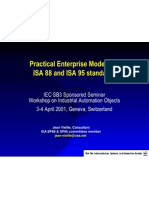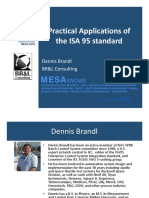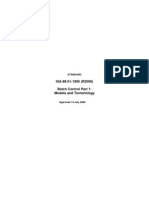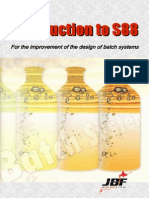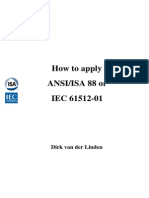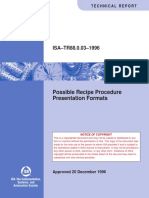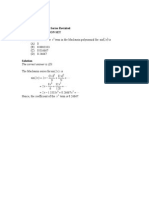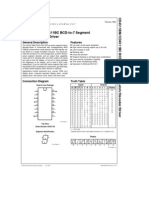An ISA95 Overview: Workflow and System Modeling For 21st Century Manufacturing Flexibility
An ISA95 Overview: Workflow and System Modeling For 21st Century Manufacturing Flexibility
Uploaded by
Lukman NulhakimCopyright:
Available Formats
An ISA95 Overview: Workflow and System Modeling For 21st Century Manufacturing Flexibility
An ISA95 Overview: Workflow and System Modeling For 21st Century Manufacturing Flexibility
Uploaded by
Lukman NulhakimOriginal Title
Copyright
Available Formats
Share this document
Did you find this document useful?
Is this content inappropriate?
Copyright:
Available Formats
An ISA95 Overview: Workflow and System Modeling For 21st Century Manufacturing Flexibility
An ISA95 Overview: Workflow and System Modeling For 21st Century Manufacturing Flexibility
Uploaded by
Lukman NulhakimCopyright:
Available Formats
Intelligent Production Management Seminar
An ISA95 Overview:
Workflow and System Modeling for
21st Century Manufacturing Flexibility
Charlie Gifford
Solutions Architect-Lean Performance Mgt.
Global Professional Services Business
Office (208) 788-5434 Fax: (208) 788-5690
Cell (208) 309-0990 Charlie.Gifford@ge.com
© 2004 GE Fanuc Automation All rights reserved.
Seminar Overview
• Goal of the ISA95 Effort
• Collaborative Production Management (CPM)
Business Drivers
• ISA95 Direction and Scope of Plant Model
• Agreement of Control Responsibility
• Object Model
– Four categories of resources
– Four categories of information
• Part 3: Manufacturing Operations Model
• Question: What does this mean for actual
project implementation? XML - schemas
• ERP-Proficy connector
• ISA95 Status
© 2004 GE Fanuc Automation All rights reserved.
Goals
• Understand the market drivers for ISA95
• Understand the two points of view for supply
chain optimization
• ISA95 Value and Direction
• Agreement of Control Responsibility
• Understand Object Model
• Proficy is ISA95 Compliant
• Understand ISA95 Business Value
© 2004 GE Fanuc Automation All rights reserved.
Ever Had This Happen?
• The VP of IT announces that the ERP
installation is done, Now the only thing left to do
it tie into the plant systems!
–PS: The interface solution is trivial and was due
yesterday.
• To reduce inventory or meet your company’s
Make-To-Order strategy, you need to run very
short schedules (multiple per day) and very fast
end of production responses (immediate)!
–PS: Don’t increase inventory or staff
© 2004 GE Fanuc Automation All rights reserved.
Goals of the 95 Effort Business
Logistics
• Integration of business (logistics)
systems to manufacturing is
hard to do Manufacturing
Operations
– Different systems, cultures,
terminology, timing...
– Benefits expected from standardization
and documentation of “best practices”
© 2004 GE Fanuc Automation All rights reserved.
Goals of the 95 Effort Business
Logistics
• Effective operation of manufacturing is
hard to do
Manufacturing
– MES solutions are too related to Operations
processing methods and too industry-
specific
– Benefits expected from standardization
and documentation of “best practices”
© 2004 GE Fanuc Automation All rights reserved.
Manufacturing Process Types
Drive Complex System Requirements
Production Types
Discrete Manufacturing Discrete
Batch Processing
Batch
Continuous Processing
Process
Workorder Mgt Categories
Engineer-to-Order
ETO MTO MTS
Make-to-Order
Make-to-Stock
The 9 combinations (or hybrids) of Production Type and Work Order
Management each have a different set of business rules processes
in their supply chain, enterprise and production base
© 2004 GE Fanuc Automation All rights reserved.
“The Goal of the Industrial Enterprise*
is to make money. Make more money now and
in the Future” The 3 Basic Metrics:
(T) Throughput : *Goldratt, The Goal, page 58-62
¾The rate: the system generates money through sales
(I) Inventory (and investments) :
¾The money the system invests in things it intends to sell
(all saleable resources: material, equipment)
(OE) Operational Expenses :
¾The money the system spends to transform Inventory
into Throughput
$$$ $$$ $$$
Throughput Inventory Operational Expenses
Money coming in Money tied up inside Money going out
© 2004 GE Fanuc Automation All rights reserved.
CPM Business Drivers
Business Processes and Metrics
Plan
Suppliers’ Customer’s
Supplier Customer
Deliver Source Make Deliver
Source Make Deliver Source Make Deliver Source
Return Return Return
Return
Supplier Your Company Customer
Internal or External Internal or External
SCOR’s Five Distinct Management Processes
Corporate approach set by optimization view
Supply Chain vs. Plant Optimization:
• 60-80% Liquid Assets are in Supply Chain
• 60-80% Tangible Assets in your Plants
© Supply-Chain Council, 2001 All rights reserved.
© 2004 GE Fanuc Automation All rights reserved.
CPM Business Drivers Summary:
Liquid Asset Optimization
• Supply chain optimization
• Capable to promise
• Reduced cycle time
• Asset efficiency
• Agile Manufacturing
• Supply Chain & Operator Empowerment
• Improved Planning
© 2004 GE Fanuc Automation All rights reserved.
CPM Business Drivers Summary:
Tangible Asset Optimization
• Increase:
–Plant Throughput
–Product quality
–Rework efficiency
–Equipment utilization
–Line uptime
–Event communication and response
© 2004 GE Fanuc Automation All rights reserved.
CPM Business Drivers Summary:
Tangible Asset Optimization
• Decrease:
– Non-value-add product costs
– Plant inventory and work-in-process (WIP)
– Regulatory reporting costs
– Rework (eliminate)
– Waste: material and human resources
– Time-to-volume on a new product introduction (NPI)
– Time-to-theoretical yield and cycle time on an NPI
– Line changeover time
– Maintenance: costs, response time, and downtime
– Total cost of ownership for IT and controls systems
© 2004 GE Fanuc Automation All rights reserved.
ISA 95 Provides Direction for Optimization
• The ANSI/ISA 95.00.01 “Enterprise - Control System
Integration - Part 1: Models and Terminology”
– Also Draft International Standard ISO/IEC 62264-1
• ANSI/ISA 95.00.02 “Enterprise - Control System Integration
- Part 2: Object Attributes”
• Draft ISA 95.00.03 “- Part 3: Activity Models of
Manufacturing Operations Management”
• Draft ISA 95.00.04 “- Part 4: Object Models and Attributes
of Manufacturing Operations Management”
• Draft ISA 95.00.05 “- Part 5: Business to Manufacturing
Transactions”
© 2004 GE Fanuc Automation All rights reserved.
Scope
ENTERPRISE
ISA S88
Standard ISA95
SITE
Standard
AREA AREA AREA
CONTINUOUS BATCH DISCRETE
PRODUCTION PROCESS PRODUCTION
UNIT CELL LINE From ISA-95 Copyright ISA 2004.
Used with permission. www.isa.org
© 2004 GE Fanuc Automation All rights reserved.
Scope
ENTERPRISE
ISA S88 95.01 & 95.02
Standard ISA95
SITE
Standard
95.03
AREA AREA AREA
CONTINUOUS BATCH DISCRETE
PRODUCTION PROCESS PRODUCTION
UNIT CELL LINE
© 2004 GE Fanuc Automation All rights reserved.
ISA95.01 Levels
Level 4
Business Planning & Logistics
Plant Production Scheduling,
Operational Management, etc
Interface addressed
in the ISA 95.01 and
Level 3 ISA 95.02 standard
Manufacturing Area addressed
Operations & Control in the ISA 95.03
Dispatching Production, Detailed Production standard
Scheduling, Reliability Assurance, ...
Levels
2,1,0
Batch Continuous Discrete
Control Control Control From ISA-95 Copyright ISA 2004.
Used with permission. www.isa.org
© 2004 GE Fanuc Automation All rights reserved.
ISA95.01 Levels
Level 4
Business Logistics
Business Planning & Logistics
Management
Plant Production Scheduling,
Operational Management, etc
Interface addressed
Level 3 (ERP) in the ISA 95.01 and
ISA 95.02 standard
Manufacturing Area addressed
Manufacturing
Operations & Control
Dispatching Production, Detailed Production
in the ISA 95.03
standard
Scheduling, Reliability Assurance, ...
Operations Management
Levels
(MES, LIMS, AM, …)
2,1,0
Batch Continuous Discrete
Control Control Control
© 2004 GE Fanuc Automation All rights reserved.
ISA 95 Part 1 and Part 2 Exchanged
Information
Information must efficiently and effectively
cross the boundary between business
and manufacturing systems
S95 Parts 1, 2 and 3
Part 1 defines:
• standard terminology and object models
• scope of the manufacturing control domain
• functions associated with the interface between
control functions and enterprise functions
• information that is shared between
control functions and enterprise functions
Part 2 defines:
• attributes for all objects that are defined in Part 1. The objects
and attributes are used for exchange of information between
different systems and used as the basis for relational databases.
Part 3 defines:
• the functions and activities at level 3
(Production Management layer)
© 2004 GE Fanuc Automation All rights reserved.
ISA 95 Models and Definitions
Domain Functions Functions
Definitions in Domains of Interest
Information Categories of Information
Definitions Information Flows of Interest
© 2004 GE Fanuc Automation All rights reserved.
S95 Functional
Enterprise-Control Model
From ISA-95 Copyright ISA 2004. Used with permission. www.isa.org
Order Product Cost Product
Processing Accounting Shipping Admin
(1.0) (8.0) (9.0)
Product
Production Inventory
Scheduling Control(7.0)
(2.0)
Production
Control ISA S95
Quality
Material and
(3.0)
Part 1&2 Assurance
Energy Control (6.0)
(4.0)
Maintenance
Procurement Research Marketing
Management
(5.0) Development & Sales
(10.0)
& Engineering
© 2004 GE Fanuc Automation All rights reserved.
Identified Information Categories (Flows)
Enterprise Information
Plant Production Scheduling,
Operational Management, etc
Production Product
Production Production
Capability Definition
Schedule Performance
InformationInformation (What to (What was
(What is make and made and
(How to make
available use) used)
a product)
for use)
Manufacturing
Control Information
Area Supervision, Production Planning,
Reliability, Assurance, etc From ISA-95 Copyright ISA 2004.
Used with permission. www.isa.org
© 2004 GE Fanuc Automation All rights reserved.
Agreements on the Control Responsibility
• Drawing the line between the Level 3 and the Level 4 functions
• A function is in the control domain if:
– The function is critical to:
> maintaining regulatory compliance.
» Includes such factors as safety, cGMP, and environmental compliance
> plant safety
> product quality
> plant reliability
• Why ?
– Where is the responsibility ?
– Who has the responsibility ?
– Where are firewalls needed (policy and technology) ?
© 2004 GE Fanuc Automation All rights reserved.
dS95.03 Production Control Functions
Where is the Line of Responsibly?
Product Production Production Production
definition capability schedule performance
Detailed
production
scheduling
Production
Production
resource
tracking
management
Production
Analysis
dispatching
Product Production
definition data
management collection
Production
execution
Level 2 Process Control
© 2004 GE Fanuc Automation All rights reserved.
Section 14: Logistics vs. Operations?
Determine Lines of Responsibility vs.
Technical Integration between Level 3 and 4
• The functions critical to Level 3:
–Product quality, Plant safety, Plant reliability
and Maintaining regulatory compliance
Maintenance Production Quality Inventory
Maintenance Maintenance Maintenance Maintenance Product Production Production Production
definitions capability request response definition capability schedule performance Quality Quality test Quality test Quality test Inventory Inventory Inventory Inventory
definitions capability request response definitions capability request response
T Detailed
maintenance
scheduling
Detailed
production
scheduling Detailed
quality test
scheduling
Detailed
inventory
scheduling
Production
Maintenance Production
Maintenance resource Inventory
resource tracking Quality Inventory
tracking management Quality test resource
R
management test resource tracking
tracking management
management
Production
Production
Maintenance Maintenance performance Inventory Inventory
dispatching Quality test Quality
dispatching analysis analysis dispatching analysis
dispatching analysis
Maintenance Maintenance Product Production Quality Inventory Inventory
Quality
definition data definition data definition data
definition test data
management collection management collection management collection
management collection
Quality test Inventory
Maintenance Production execution
execution execution execution
Level 2
© 2004 GE Fanuc Automation All rights reserved.
4x4 Object Model Describes Data Flows
• Four categories of resources
– Personnel
– Equipment
– Material (and Energy)
– Process Segments
• Four categories of information
– Capability & Capacity Definition
– Product Definition
– Production Schedule
– Production Performance
© 2004 GE Fanuc Automation All rights reserved.
S95 Functional
Enterprise-Control Model
From ISA-95 Copyright ISA 2004.
Used with permission. www.isa.org
Order Product Cost Product
Processing Accounting Shipping Admin
(1.0) (8.0) (9.0)
Product
Production Inventory
Scheduling Control(7.0)
(2.0)
Production
Control ISA S95
Quality
Material and
(3.0)
Part 1&2 Assurance
Energy Control (6.0)
(4.0)
Maintenance
Procurement Research Marketing
Management
(5.0) Development & Sales
(10.0)
& Engineering
From ANSI/ISA-95.00.01-1995 Copyright ISA 2000. Used with permission. www.isa.org
© 2004 GE Fanuc Automation All rights reserved.
Four Resource Object Models
Personnel resources managed for production
People
Equipment resources managed for production
Equipment
Material and Energy resources
Materials managed for production
Business view of production processes
Process Segments
© 2004 GE Fanuc Automation All rights reserved.
Persons and Personnel Classes with
Required Properties
• The picture below represents person and
personnel class information
Supervisor Professional Laborer Operator Pump Draftsman
Engineer Mechanic
Qualification
Test
Qualification
Sally Jones- ID#12344 Joe Smith - ID#12345 Test Results
© 2004 GE Fanuc Automation All rights reserved.
Standard Terminology For
Equipment Classification
ENTERPRISE
Level 4 activities
typically deal with
these objects SITE
AREA
Level 3
activities
typically PROCESS PRODUCTION PRODUCTION STORAGE
CELL UNIT LINE AREA
deal with
these WORK STORAGE
UNIT
objects CELL UNIT
Lower level Lower level Lower level Lower level
equipment used equipment used equipment used equipment used
in batch operations in continuous in repetitive or in inventory
operations discrete operations operations
© 2004 GE Fanuc Automation All rights reserved.
Material Classes, Definition, Lots,
Sublots, and Properties
• Standard terminology for defining material
information
Material Class Material Definition Lot Sublot
HCl Acid HCl 50% HCL-50-100019 HCL-50-100019
Barrel 15
l l
ria ria
e e
at ss at ition
M la M in
C e f
D
pH Density Color Purity
QA Test QA Test Location
Results Specification
pH Density Color Purity
1.0 1.05 Straw 99.5%
© 2004 GE Fanuc Automation All rights reserved.
Process Segments
• The business view of production
Raw Finished
Materials Products
Pharmaceutical Manufacturing
(3 Segments)
Make
Make Package
Active
Pills Doses
Ingredient
Inventory tracked Inventory tracked Inventory tracked
for Active Ingredient for Pills for Pill Packs
Know throughput, Know throughput, Know throughput,
resources and time to resources and time to resources and time to
make Active Ingredient make Pills make Pill Packs
© 2004 GE Fanuc Automation All rights reserved.
Capability, Product, Schedule, and
Performance Information
What is available for use for production
Product
Time
Capability/Capacity
What is needed to make a product
Product
Definitions
What to make and resources to use
Production
Schedule
What was made and
resources actually used
Production
Performance
© 2004 GE Fanuc Automation All rights reserved.
Production Capability Models
Product
People Time
Capabilities
Equipment What is available
- Currently
- In the future
- Per resource
Materials - Per segment of
production
- What is available
- What is unattainable
- What is committed
Segments
© 2004 GE Fanuc Automation All rights reserved.
Production Capability & Capacity
Current Production Capacity
Production Capacity
Capacity
Unattainable Capacity
Available Capacity
Committed Capacity
Time
Current Capacities
© 2004 GE Fanuc Automation All rights reserved.
Product Definition
• Shared information about each product between
Level 3 and 4
–References manufacturing instructions
> For Continuous may be flow sheets
> For Batch may be site or master recipes
> For Discrete may be setup or assembly instructions
–Defines all materials used by manufacturing
© 2004 GE Fanuc Automation All rights reserved.
Product Definition
• References the Bill of Materials
• References the Bill of Resources
• Defines resources required per segment
–Equipment
–Personnel
–Material
© 2004 GE Fanuc Automation All rights reserved.
Per Product Definitions
Scheduling Material
System System
Product Definition
Bill Of Resources Bill Of Materials
e.g. 10 Speed Bicycle e.g. 10 Speed Bicycle
Product f
f
ll O es Segments ll O als
Bi urc Bi i
er
so at
M
Re
Manufacturing
Bill
Production Rules
Frame : 1
e.g.
Wheels : 2
Frame Final
Paint 10 Speed Bicycle Chain : 1
ly b s
m
Assembly Assembly s se tion Seat : 1
A ruc
st
In Handlebars :1
Color Brake Pads : 4
Frame Seat
Manufacturing ...
Type Height System
© 2004 GE Fanuc Automation All rights reserved.
Production Schedule
• Production Schedule
• Production Request What to make
• Segment Request - Priority and/or dates
People • Expected Produced - What to use:
Material -Materials
-Equipment
• Expected Consumed -personnel
Material - Production parameters
• Expected Personnel (e.g. Color, Options,…)
• Expected Equipment
Equipment
• Production Parameters
•…
Materials
Production
Schedule
Per location (Site, Area, …)
Per week, day,
shift, order, …
Segments
© 2004 GE Fanuc Automation All rights reserved.
Production Performance
• Production Performance
• Production Response
• Segment Response
People • Produced Material What was made
Actual - What material was
• Consumed Material actually produced
- What materials were
Actual
actually consumed
• Personnel Actual - Equipment used
Equipment • Equipment Actual - Personnel used
• Production Data - Production data
•… (e.g. Purity, density,…)
Materials
Per location (Site, Area,
…)
Production
Segments Per shift, hour,
Performance end of batch, …
© 2004 GE Fanuc Automation All rights reserved.
ISA95 Part 3: Activity Models of
Manufacturing Operations
Order
Processing
(1.0) Product Cost Product
Accounting Shipping Admin
(8.0) (9.0)
Production
Scheduling PRODUCTION
(2.0)
OPERATIONS
INVENTORY
Material and Production OPERATIONS Product
Energy Control Control Inventory Control
(4.0) (3.0) (7.0)
INVENTORY
OPERATIONS QUALITY
ASSURANCE
OPERATIONS
Procurement Quality
MAINTENANCE Assurance
(5.0)
OPERATIONS (6.0)
Marketing
In Development & Sales
Maintenance
Draft 17 Available Management Research
(10.0) Development
and Engineering
© 2004 GE Fanuc Automation All rights reserved.
d95.03 Manufacturing Operations
Functions
Product Production Production Production
definition capability schedule performance
Detailed
production
scheduling
Production
Production
resource
tracking
management
Production
Analysis
dispatching
Product Production
definition data
management collection
Production
execution
Equipment and Process Operational Operational Equipment and Process
Specific Production Rules Commands Responses Specific Data
Level 2 Process Control From ISA-95 Copyright ISA 2004.
Used with permission. www.isa.org
© 2004 GE Fanuc Automation All rights reserved.
Business plan* (APICS terminology)
(Per Product Line, Per Time – Very Long Time Horizon)
Production
Demand plan* (APICS terminology)
Schedule
Flow
(Per Product, Per Time –Long Time Horizon)
1.1 Production Forecasting Activity (ISA-95.01 )
Production plan* (APICS terminology)
(Per Product, Per Time - – Long Time Horizon)
2.4 Production scheduling activity (ISA-95.01)
Production schedule – (Master production schedule - APICS terminology)
(Per Site/Area, Per Product, Per Time – Medium Time Horizon)
Detailed production scheduling activity (ISA-95.03)
Detailed production schedule
(Per Workcenter, Per Product/Intermediate, Per Time – Short Time Horizon)
Production dispatching activity (ISA-95.03)
Production Dispatch list
(Per Workcenter or Workcenter element, Per produced item, Per Time – Very Short Time Horizon)
* Not in the scope of this standard
© 2004 GE Fanuc Automation All rights reserved.
Other Enterprise Activities in
Manufacturing Operations
• Some actives are not specific to manufacturing
• ISA-95.03 lists references to standards in these areas
Level 4
Inventory Management Management
Major Level 3 Operations of Information of Configuration
Activities
Maintenance Quality Management
Within Operations Operations of Security
Manufacturing
Production Management Management
Operations Operations of Documentation of Compliance
Level 2
Activity detailed
Activity not detailed
Activity outside scope
© 2004 GE Fanuc Automation All rights reserved.
Question: What does this mean for actual
project implementation?
Answer: XML Schemas:
Common Language and Common Protocol
between Levels 3 and 4
B2MML - Business to Manufacturing
Markup Language
• XML-based implementation of ISA95 standard developed by
the volunteer effort of the WBF's XML Working Group
• Provides a set of XML schemas based upon the ANSI/ISA 95
family of standards. The schemas were written using the World
Wide Web Consortium’s XML Schema language (XSD)
• Used to integrate ERP and supply chain management systems
with manufacturing systems
• Formal way to document information and agreements
• NOTE: Does not define TRANSACTIONS, just the data to be
used inside other transaction systems (e.g. OAG)
© 2004 GE Fanuc Automation All rights reserved.
B2MML: Schemas
• Common Schema
• Equipment Schema
• Material Schema
• Personnel Schema
• Process Segment Schema
• Product Definition
• Production Capability
• Production Performance
• Production Schedule
• Maintenance Schema
© 2004 GE Fanuc Automation All rights reserved.
Why XML ?
• Openness
• Simplicity
• Self-describing
• Interoperability
• Structure
• Extensibility
• Platform independency
• X-Path – Query Language
• Self-documenting
• Fully Extensible
© 2004 GE Fanuc Automation All rights reserved.
ERP - Proficy Connector
ERP System
XML Input Schemas B2MML
•Equipment
•Maintenance
•Material
•Process Segment
•Product Definition
•Production Capability
•Production Performance
•Production Schedule
S95 Connector
XML Standard Schema –
Transaction Table compatible
Proficy Transaction Table
© 2004 GE Fanuc Automation All rights reserved.
S95 Business Values
• Easier Level 3 product comparison, selection, and replacement
using consistent models and language across all industries
• Enhanced protection of end users’ intellectual property through
consistent supplier product functional partitioning
• Easier flow of information from consistent messaging between
business and production systems
• Faster implementation of integration projects by enabling
industry-wide standards using current technologies
• LARGE Reduction implementation and maintenance costs for
enterprise integration through the use of single interface schema
© 2004 GE Fanuc Automation All rights reserved.
Status
• ISA95.00.01 & ISA.95.00.02 available
• IEC/ISO 62264-1 available from IEC & ISO
• ISA 95.00.03 /.04/.05 in draft
– Still under development in the committee
• World Batch Forum
– Developed XML Schemas for the exchanged
information
• Vendors
– Many currently using ISA-95 models in
development and current products
• Users
– Specifying ISA-95 in their RFPs
© 2004 GE Fanuc Automation All rights reserved.
You might also like
- The Road to Integration: A Guide to Applying the ISA-95 Standard in ManufacturingFrom EverandThe Road to Integration: A Guide to Applying the ISA-95 Standard in ManufacturingRating: 4.5 out of 5 stars4.5/5 (5)
- Isa - 95Document10 pagesIsa - 95peednaskNo ratings yet
- Isa 95.00.02-2001Document104 pagesIsa 95.00.02-2001Alexander Dueñas Salazar100% (5)
- Preview ANSI+ISA+95.00.02-2018Document21 pagesPreview ANSI+ISA+95.00.02-2018Abin PmNo ratings yet
- Ansi - Isa-88.00.01-2010Document4 pagesAnsi - Isa-88.00.01-2010RitchieRichardNo ratings yet
- Isa S88 PDFDocument17 pagesIsa S88 PDFAnonymous 1XHScfCI50% (2)
- ISA-88 and ISA-95 in The Life Science IndustriesDocument29 pagesISA-88 and ISA-95 in The Life Science IndustriesMomentum Press100% (2)
- Applying ISA-88 in Discrete and Continuous ManufacturingDocument27 pagesApplying ISA-88 in Discrete and Continuous ManufacturingMomentum Press100% (1)
- ISA 95 White Paper - PDF - FinalDocument8 pagesISA 95 White Paper - PDF - FinalburcumusaogluNo ratings yet
- Lewandowski CAPADocument56 pagesLewandowski CAPAKristof MCNo ratings yet
- Ansi Isa-95.00.06-2014Document66 pagesAnsi Isa-95.00.06-2014RAHAOUI MehdiNo ratings yet
- Isa S95-222Document32 pagesIsa S95-222optisearchNo ratings yet
- Best Practices and Bench Marking of Control System Integrator SDocument8 pagesBest Practices and Bench Marking of Control System Integrator SHector TostadoNo ratings yet
- Project Report On Micromax MobilesDocument25 pagesProject Report On Micromax MobilesAnilGoyal100% (2)
- Sample Personal Statement For Computer ScienceDocument3 pagesSample Personal Statement For Computer SciencededejohnNo ratings yet
- Software Engineering: Computer Science: An Overview Twelfth EditionDocument32 pagesSoftware Engineering: Computer Science: An Overview Twelfth EditionadeelNo ratings yet
- Practical Enterprise Modelling: ISA 88 and ISA 95 StandardsDocument59 pagesPractical Enterprise Modelling: ISA 88 and ISA 95 StandardsAngie GordiansNo ratings yet
- T061 Isa95-04Document32 pagesT061 Isa95-04Haogoaro ZrNo ratings yet
- IsaDocument59 pagesIsaoptisearchNo ratings yet
- ISA 95 OverviewDocument51 pagesISA 95 Overviewajschad100% (2)
- 2002-10 ISA S95 Part 3 OverviewDocument12 pages2002-10 ISA S95 Part 3 OverviewDo Van TuNo ratings yet
- MES Product Survey Flyer 2015Document4 pagesMES Product Survey Flyer 2015dhinojahimeshNo ratings yet
- WBF Implementing B2MMLDocument9 pagesWBF Implementing B2MMLvpascarielloNo ratings yet
- Aplicacion Isa 95Document64 pagesAplicacion Isa 95FRANCISCO JAVIER Sampedro nuñezNo ratings yet
- Applying S88 PDFDocument171 pagesApplying S88 PDFHanif PayandehNo ratings yet
- Isa 88 01 1995 R2006 PDFDocument100 pagesIsa 88 01 1995 R2006 PDFnieporgoNo ratings yet
- Introduction To S88Document56 pagesIntroduction To S88Jennifer MatthewsNo ratings yet
- ISA88 How To Apply PDFDocument24 pagesISA88 How To Apply PDFnieporgo100% (2)
- Ref Batch ManagementDocument280 pagesRef Batch Managementjustine_fabian2No ratings yet
- Work Orders For Operations Maintenance ActivitiesDocument10 pagesWork Orders For Operations Maintenance ActivitiesKushal BnNo ratings yet
- S88 Lecture Notes ISA S88Document20 pagesS88 Lecture Notes ISA S88houstonmathNo ratings yet
- Isa95 - Arquitectura OpcDocument69 pagesIsa95 - Arquitectura Opcdavidmn19No ratings yet
- Automating ProceduresDocument38 pagesAutomating Proceduressahil4INDNo ratings yet
- Mesatutorial - Isa95 Enterprise IntegrationDocument64 pagesMesatutorial - Isa95 Enterprise Integrationchandramohan murugan100% (1)
- Mes PDFDocument28 pagesMes PDFRahmat DennyNo ratings yet
- ISA-TR88.0.03-1996: Possible Recipe Procedure Presentation FormatsDocument22 pagesISA-TR88.0.03-1996: Possible Recipe Procedure Presentation FormatsRaul Sedano LauNo ratings yet
- ISA-106: Using Procedural Automation To Improve Operational EfficiencyDocument35 pagesISA-106: Using Procedural Automation To Improve Operational EfficiencyGlauco SantiagoNo ratings yet
- OPC-UA For ISA95Document15 pagesOPC-UA For ISA95vpascarielloNo ratings yet
- ISA-95 Implementation ExperiencesDocument37 pagesISA-95 Implementation ExperiencesMomentum Press33% (3)
- Integrating ISA 88 and ISA 95Document13 pagesIntegrating ISA 88 and ISA 95Ahmed SamiNo ratings yet
- I2 - An Overview of Wonder Ware MES Products - Jan Rasmussen Version 0.92 NXPowerLiteDocument54 pagesI2 - An Overview of Wonder Ware MES Products - Jan Rasmussen Version 0.92 NXPowerLiteamanzoor77No ratings yet
- S95 TutorialDocument35 pagesS95 TutorialEsther Claravalls LópezNo ratings yet
- IEC 61499 Function Block Model: Facts and Fallacies: IEEE Industrial Electronics Magazine January 2010Document16 pagesIEC 61499 Function Block Model: Facts and Fallacies: IEEE Industrial Electronics Magazine January 2010drgry100% (1)
- OPC UA & Smart-Ready Factory: All About Data Connectivity SolutionsDocument46 pagesOPC UA & Smart-Ready Factory: All About Data Connectivity SolutionsMahrus FuadNo ratings yet
- S88-01 Update 04apr2008Document135 pagesS88-01 Update 04apr2008AjinkyaPatilNo ratings yet
- A Fuzzy PID Controller For Exhaust Gas Recirculation SystemDocument7 pagesA Fuzzy PID Controller For Exhaust Gas Recirculation SystemAhmad ElsheemyNo ratings yet
- Business To Manufacturing Markup Language Batch Production Record Version 6.0 - March 2013 Batchml - Batch Production RecordDocument40 pagesBusiness To Manufacturing Markup Language Batch Production Record Version 6.0 - March 2013 Batchml - Batch Production RecordWass GharbiNo ratings yet
- Wonderware MES Operations en 0116 PDFDocument8 pagesWonderware MES Operations en 0116 PDFdhinojahimeshNo ratings yet
- IEC 61850 Based OPC UA CommunicationDocument9 pagesIEC 61850 Based OPC UA Communicationabdel taibNo ratings yet
- Design of Manufacturing Execution System For FMCG IndustriesDocument9 pagesDesign of Manufacturing Execution System For FMCG IndustriesMohit NatuNo ratings yet
- Ansi Isa S88.01 1995Document98 pagesAnsi Isa S88.01 1995Alejandro Godoy ヅNo ratings yet
- Python OPC-UA DocumentationDocument721 pagesPython OPC-UA DocumentationdivergerNo ratings yet
- Access and OPC PDFDocument12 pagesAccess and OPC PDFsan moedanoNo ratings yet
- Initial Assessment of Manufacturing Execution SystemsDocument58 pagesInitial Assessment of Manufacturing Execution SystemsĐan VũNo ratings yet
- CAP Question Sample PDFDocument36 pagesCAP Question Sample PDF-' Nando100% (1)
- IsaDocument19 pagesIsaPaul Zagaceta Lizares100% (1)
- Isa 95 98 106Document20 pagesIsa 95 98 106alejandrozabalaNo ratings yet
- Implementing ISA S88 For A Discrete Process With The Bottom-Up ApproachDocument10 pagesImplementing ISA S88 For A Discrete Process With The Bottom-Up ApproachPaulo Ricardo Siqueira SoaresNo ratings yet
- ISA 95 Integration Standards A Complete Guide - 2020 EditionFrom EverandISA 95 Integration Standards A Complete Guide - 2020 EditionNo ratings yet
- ISA-95 Integration Standards A Complete Guide - 2019 EditionFrom EverandISA-95 Integration Standards A Complete Guide - 2019 EditionNo ratings yet
- ISA 95 Integration Standards A Complete Guide - 2021 EditionFrom EverandISA 95 Integration Standards A Complete Guide - 2021 EditionNo ratings yet
- Certified Automation Professional A Complete Guide - 2020 EditionFrom EverandCertified Automation Professional A Complete Guide - 2020 EditionNo ratings yet
- SYNTHESISDocument15 pagesSYNTHESISdabhiabhishek66No ratings yet
- Actuateur Gras PD - 90CADocument4 pagesActuateur Gras PD - 90CAEMA54No ratings yet
- The Complete Android GuideDocument282 pagesThe Complete Android Guidedeisecairo100% (1)
- Systemboard Viewer PDFDocument19 pagesSystemboard Viewer PDFD.B Kim (aka akuma)No ratings yet
- Quiz 01aae Taylorseries AnswersDocument7 pagesQuiz 01aae Taylorseries AnswersYahya IsiedNo ratings yet
- String HashingDocument1 pageString HashingJulian AlifirmanNo ratings yet
- Ayushi AgarwalDocument1 pageAyushi Agarwalzainablemonwala1No ratings yet
- 05 PROFINET IntroductionDocument42 pages05 PROFINET Introductionleningfe100% (1)
- HCD RG66TDocument72 pagesHCD RG66Tfat322100% (1)
- br5 Scheda en 0Document2 pagesbr5 Scheda en 0Mihai BordeianuNo ratings yet
- Amended Tender Document For University Management System 3101262Document43 pagesAmended Tender Document For University Management System 3101262Abdullah MostafaNo ratings yet
- Datasheet 4511Document8 pagesDatasheet 4511Marcelo C. OliveiraNo ratings yet
- Digital Signal Processing MCQDocument43 pagesDigital Signal Processing MCQmuhanad alkhalisyNo ratings yet
- 1.1.1.1-1.1.2.1 Open DSA NotesDocument2 pages1.1.1.1-1.1.2.1 Open DSA NotesTiffany TranNo ratings yet
- STMPL Joining Kit PDFDocument13 pagesSTMPL Joining Kit PDFPratima SharmaNo ratings yet
- Artificial Intelligence Theory and ApplicationsDocument32 pagesArtificial Intelligence Theory and Applicationskd17209No ratings yet
- 0014 Excel For Advanced UsersDocument6 pages0014 Excel For Advanced UsersHanna CliquerinaNo ratings yet
- Chemformula: Typeset Chemical Compounds and Reactions Clemens NiederbergerDocument41 pagesChemformula: Typeset Chemical Compounds and Reactions Clemens NiederbergercamilasccvNo ratings yet
- Horse Welfare: Well-Being Tool KitDocument44 pagesHorse Welfare: Well-Being Tool KitAbolfazl GolariNo ratings yet
- Part3 PDFDocument85 pagesPart3 PDFRupesh Kumar NidhiNo ratings yet
- Guide For Students Applying For Postgrad Internship Online 1Document1 pageGuide For Students Applying For Postgrad Internship Online 1Kevin MarquezNo ratings yet
- FSC For Retail Banking Point of ViewDocument2 pagesFSC For Retail Banking Point of Viewtranhieu5959No ratings yet
- 998-20710038 - Eliwell - NA - 2019a - Catalog - GMA - BrochureDocument60 pages998-20710038 - Eliwell - NA - 2019a - Catalog - GMA - BrochureTesoro HonNo ratings yet
- Project Report (TEAM 7)Document20 pagesProject Report (TEAM 7)Anshul MittalNo ratings yet
- Phpstan: Finding Bugs in Your Code Without Even Running It: Darkmira Tour PHP 2019Document38 pagesPhpstan: Finding Bugs in Your Code Without Even Running It: Darkmira Tour PHP 2019MohsinNo ratings yet
- Template CV 8Document1 pageTemplate CV 8admin hrdakpNo ratings yet


















